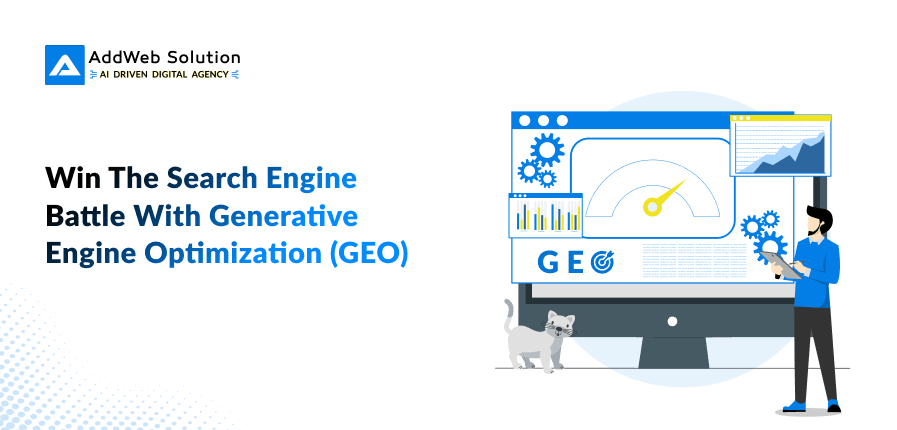In the constantly changing digital landscape, businesses struggle to achieve the top positions on search engine results pages.
As AI and ML advance, search engine optimization has gone beyond keyword and backlink optimization. That is where Generative Engine Optimization (GEO) comes into play.
A method that combines traditional SEO with generative AI to improve content creation, boost user experience, and keep content relevant.
This blog will discuss how GEO can help businesses win the battle in search engines and keep ahead of the competition.
What is Generative Engine Optimization (GEO)?
Generative Engine Optimization (GEO) is a concept that integrates Generative AI with traditional SEO strategies to create more innovative, more efficient, and user-focused content.
While conventional SEO focuses on optimizing content based on keyword strategies and ranking factors, GEO uses AI-driven tools to generate high-quality, relevant content that directly aligns with what users are searching for.
GEO vs. Traditional SEO: What’s the Difference?
While both SEO and GEO target the improvement of search rankings, they do this in two radically different ways:
- Traditional SEO is mainly about content optimization through keyword research, backlinks, and technical improvements. This means continuous manual updates with changing algorithms.
- Generative Engine Optimization (GEO) utilizes AI to automate and enhance processes. It analyzes real-time search intent and generates dynamic, personalized content that adapts to changing trends and improves the user experience.
How Does GEO Work?
GEO uses a combination of many techniques that improve SEO:
- Content Generation: Generative AI tools provide highly relevant content for specific user queries. This improves how search engines rank by offering solutions related to user intent.
- Personalization: GEO uses AI to analyze users’ preferences, which implies changing content to meet particular target needs.
- Search Trend Analysis: The data and trends emerging from the search will be added, allowing for up-to-date content relevant to the targeted people.

Optimize Smarter with Generative Engine Optimization.

Pooja Upadhyay
Director Of People Operations & Client Relations
The Role of AI and Machine Learning in GEO
Artificial intelligence and machine learning are central to GEO’s success. With algorithms becoming more sophisticated, search engines like Google can understand natural language better than ever. Here’s how AI and ML enhance GEO:
- Natural Language Processing (NLP): AI-powered NLP helps search engines understand context, sentiment, and the intent behind search queries. Businesses can better meet user expectations and enhance rankings by creating content that aligns with NLP.
- Predictive Analytics: AI tools analyze current trends and predict future search patterns. This allows businesses to create content that anticipates what users will search for next.
- Content Optimization: AI can analyze and suggest keyword optimizations, metadata adjustments, and content structure improvements to increase a page’s chances of ranking higher on SERPs.
Why GEO is the Future of SEO?
GEO is set to change the way we think about SEO for several reasons:
- Improved Content Creation: Content is no longer just about keywords. GEO tools can generate creative, unique, and highly relevant content tailored to meet specific searcher intent. This allows businesses to stay ahead in the competitive content landscape.
- Better User Experience: GEO makes content more user-oriented, improving engagement metrics. Search engines favor sites that provide a superior user experience, directly improving rankings.
- Real-Time Adaptation: Since predictive analytics will be part of GEO, companies can adjust their content accordingly by promptly identifying new trends and changes in user behavior.
- Scalability: GEO’s automation makes content generation and optimization possible for large-scale websites or businesses that use extensive digital marketing.
Data and Statistics Supporting GEO’s Effectiveness
To better understand the increasing role of AI in SEO, let’s consider some relevant statistics:
- AI-Driven Content Creation: A report from Europol suggests that by 2026, artificial intelligence could generate up to 90% of online content.
- Search Trends: A survey by Capterra indicates that businesses plan to use generative AI for an average of 48% of their social media content by 2026, up from 39% in 2024.
How to Implement GEO in Your SEO Strategy?
To tap into the power of GEO, businesses should consider the following steps:
1. Leverage AI for Content Generation
Tools like GPT-4, Jasper AI, and other AI-powered content creation platforms can help generate high-quality content at scale. These tools not only produce unique content but also tailor it to the preferences of your target audience.
2. Optimize for User Intent
Instead of focusing only on keywords, focus on the intent of users. Tools such as Answer the Public can be used to determine what users are asking in your niche. Then, you will be able to create content that directly answers those needs, which would increase your ranking chances.
3. Stay Updated with Search Trends
Use tools like Google Trends to stay ahead of emerging search trends. Businesses can create timely, relevant content that resonates with users by tracking trending keywords and phrases.
4. Personalize Content
AI tools can help analyze visitor behavior on your site, allowing you to tailor content to specific user preferences. Personalization can significantly enhance engagement, leading to better rankings.
5. Improve Technical SEO with AI
AI can help optimize the technical aspects of SEO, such as metadata, image alt tags, and internal linking. By optimizing these, you will improve your site’s crawlability and indexing.

Geo-Friendly SEO Best Practices
Implementing GEO strategies can elevate your SEO efforts by ensuring your content is optimized for voice search, real-time analytics, and enhanced visibility through rich snippets.
- Voice Search Optimization: Since voice search is becoming increasingly common, GEO can optimize content for voice queries by focusing on natural language and long-tail keywords.
- AI-Powered Analytics: Monitor your content’s performance with AI and adjust it in real time. AI tools will be able to find underperforming pages and recommend improvements.
- Rich Snippets and Structured Data: Use structured data to improve your chances of being shown in rich snippets, further improving visibility and click-through rates.
Conclusion
Generative Engine Optimization (GEO) will redefine the future of SEO. It combines the power of AI with traditional optimization strategies, helping businesses stay ahead in the competitive digital landscape.
GEO enhances content creation, optimizes the user experience, and provides real-time insights, making it an essential tool for any business seeking to dominate the search engine landscape.
Implementing GEO strategies today will ensure businesses remain on top of the game in SEO, provide the highest quality content, and respond to the ongoing evolution of users’ and search engines’ expectations.
Ready to enhance your SEO efforts? Partner with AddWeb Solution to integrate GEO into your strategy and watch your rankings soar.
Frequently Asked Questions (FAQs)
What is the difference between GEO and traditional SEO?
Traditional SEO optimizes content for keywords and backlinks, while GEO incorporates AI to create more personalized content that meets the user’s intent.
How does GEO enhance user engagement?
GEO optimizes content in a manner better suited to meeting users’ needs, creating a better user experience. This leads to increased time spent on site, decreased bounce rates, and a higher conversion rate.
Can GEO improve my ranking on search engines?
Yes, by creating content that aligns with search intent and leveraging AI tools for optimization, GEO can improve your website’s relevance and user engagement, which are critical factors for ranking.
Is GEO scalable for large websites?
Yes, GEO can be highly scalable. AI tools can automate content generation and optimization, making managing large websites and generating content at scale easier.

Elevate Your Rankings With Smarter Optimization!

Pooja Upadhyay
Director Of People Operations & Client Relations

